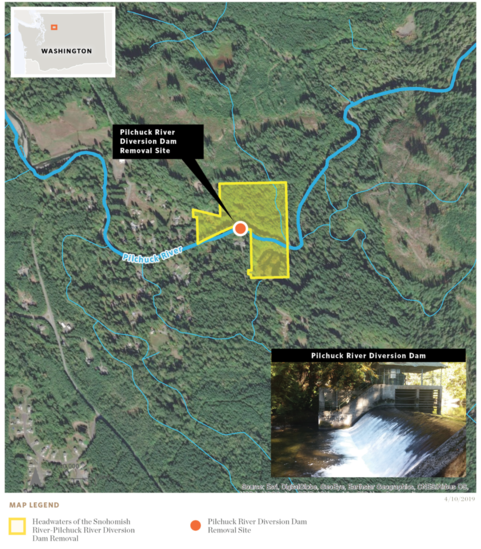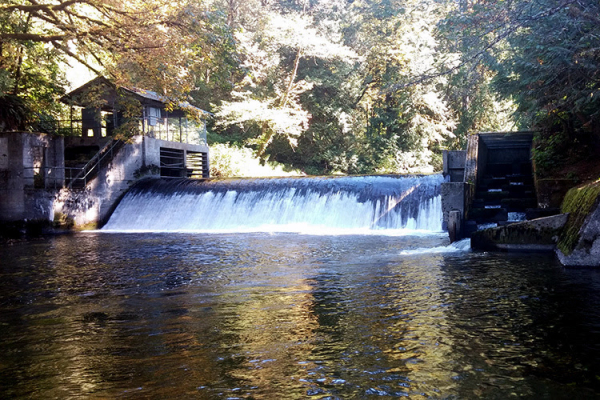Dam Removal on Washington River Will Renew Fishery Habitat
 |
Washington’s Pilchuck River is close to once again flowing freely after more than 100 years, thanks to a NOAA-supported effort to remove an obsolete dam. Once restoration work is complete, the project will reopen 37 miles of habitat for fish and help protect downstream communities from flooding.
Removing a Dam to Protect People and Fish
The Pilchuck River Dam is located southeast of the city of Granite Falls and is owned by the City of Snohomish, Washington. Built in 1912, the 60-foot wide and 10-foot tall dam previously provided drinking water to the City of Snohomish. But the city now uses water from the more reliable—and less costly—City of Everett water source in the Sultan River watershed, rendering the Pilchuck River Dam unnecessary.
With the dam no longer being used, what remained was an aging, potentially dangerous structure that posed a risk to downstream communities. The dam was at low risk of failure, but without frequent maintenance it might have degraded in the future. That would have posed a risk to downstream landowners and residents if the dam were to fail. Removing the dam increases safety in the area while also providing maintenance cost savings to the City of Snohomish.
Removing the dam also benefits threatened species such as chinook salmon, steelhead, and bull trout. Chinook salmon in particular serve as a vital food source to endangered Southern Resident killer whales.
The Pilchuck River Dam is located roughly where the middle and upper portions of the Pilchuck River meet. The middle portion of the river, below the dam, lacks high-quality habitat and has high summer temperatures. Above the dam, in the upper portion of the river, high-quality habitat is abundant and water temperatures are cooler. Removing the Pilchuck River Dam allows fish to access more than 37 miles of this high-quality habitat.
The Snohomish River Basin Salmon Conservation Plan identifies the Pilchuck River as an important location for habitat restoration. Removal of the Pilchuck River Dam is also listed as a priority in the Puget Sound Steelhead Recovery Plan and the recommendations of the Southern Resident Orca Task Force.
Restoring a Free-Flowing River
Demolition of the Pilchuck River Dam began in late July, and the main spillway of the dam is now gone. Throughout the remainder of this summer, other structures such as concrete and buried crib dams, the water intake, and the fish ladder will be demolished.
Once the dam has been fully removed, restoration work will focus on reforming the river channel and restoring the river’s natural processes. The goal is for the restored river to closely resemble how it looked before the dam was built, allowing for complete restoration to a natural, free-flowing waterway.
Working Toward a Shared Goal
This NOAA-supported dam removal effort is a collaboration between the Tulalip Tribes and the City of Snohomish. The Tulalip Tribes work to protect and preserve the resources their people have depended on for fishing, hunting, and cultural connections for thousands of years. Both entities want to restore and enhance the once abundant resources provided by the Pilchuck River, such as clean water and abundant salmon runs. Partnering on this project has provided opportunities for the teams to meet, better understand each other, and come up with creative solutions to problems.
In addition to the Tulalip Tribes and City of Snohomish, NOAA and many other partners have been involved in the effort to remove the Pilchuck River Dam. These partners include:
- Puget Sound Partnership
- U.S. Environmental Protection Agency
- U.S. Geological Survey
- Puget Sound Acquisition and Restoration Fund
- Washington State Salmon Recovery Funding Board
- Paul G. Allen Family Foundation
The NOAA Restoration Center provided financial support to the dam removal effort with funding through our Community-based Restoration Program.



 Advertising
Advertising